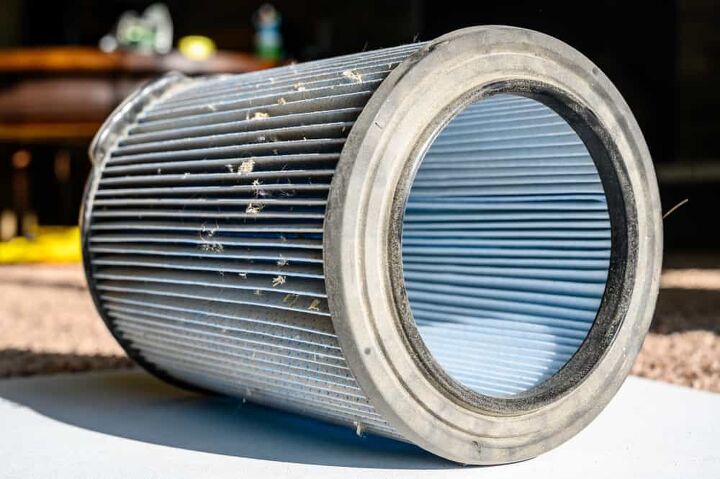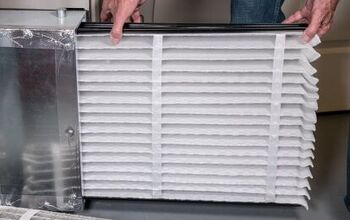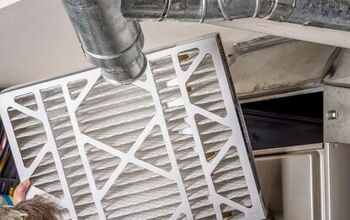Can You Use A Shop Vac Without A Filter? (Find Out Now!)

Shop Vac vacuums are not exactly the most affordable type of vacuum, but they are the most powerful. Unfortunately, most (if not all) Shop Vacs require a specialty filter. If you’re like most builders, you probably have been wondering if you could just use the ol’ vacuum without changing or using a filter. So, can it actually be done?
While the Shop Vac will turn on without a filter, using it without a filter is a terrible idea. At best, you will have a vacuum that won’t work as well as you’d have hoped. At worst, you might have permanent damage that could potentially break your vacuum.
While wanting to cut corners is totally understandable, this is not a corner you want to cut. If you are still thinking about working around this issue, keep reading this article. You’ll change your mind sooner than later.
What Happens If You Use A Shop Vac Without A Filter?
Just like with any other hardware tool that you could operate without a part, a filterless Shop Vac will not run the way it’s supposed to. How badly it runs, though, can vary greatly from model to model. Most, if not all, Shop Vac vaccums will turn on and run for a fair amount of time without a filter.
Unfortunately, that’s all we can tell you and have it be true for all models. Some models will blow dirt and dust out of the back end of their unit. Others may get debris stuck in the motor, which will cause the motor to get serious damage. Some will simply be unable to work as well as they should in terms of suction power. Even more may end up overheating.
Will Any Shop Vac Filter Work?
Along with getting a filter for your Shop Vac, it’s important to remember that you also have to choose the right filter for the job at hand. When shopping for a filter, it’s best to keep these things in mind:
- You have to get an appropriate filter for the model you have. There are approximately a dozen or so filters that you could buy for Shop Vac products. You will need to choose a filter that’s the right size for your vacuum, otherwise it won’t fit.
- Wet and dry vacuuming will usually require different filters. The filters from Shop Vac have labels that show whether they are meant for wet or dry vacuuming. If you are unsure whether you should get a wet or dry vacuum, a generic use filter is best. It has similar workings to both, and while it’s not ideal, it can do the job.
- If the dust that you are vacuuming is extra fine, then get a HEPA filter. Yes, they do exist and they will help you ensure that you won’t get sick from the cleanup. They may be pricier, but they’ll work well.
Can You Use Third-Party Shop Vac Filters?
While there are third-party filters that are made to be compatible with Shop-Vac products, it’s generally not a good idea to use them. There is no guarantee that they will be able to fit on the model you have, even if they’re designed with your specific model in mind. Moreover, there’s no guarantee that you will get the same quality as what you would get from the real thing.
How Much Are Shop Vac Filters?
This all depends on what kind of Shop Vac you have. Most Shop Vac filters will cost between $6 and $45 per filter pack. Each pack can have anywhere from one to three, depending on the model that it’s built for. It’s worth noting that filters for larger models will cost more, and that HEPA filters may cost additional.
In terms of figuring out whether wet or dry filters are more expensive, the answer seems to be pretty clear. Wet filters are going to be the more expensive option.
Why Is My Shop Vac Blowing Dust Out The Back?
If you don’t have a filter, it’s safe to say that this is because you need to have a filter to properly direct the particles your vacuum is supposed to pick up. However, there are times when this can also happen when you have a filter added into your vacuum. If this is the case, you need to do the following:
- Check to see if the filter is the right type for your vacuum. A mismatched filter can easily cause your vacuum to blow dust out of places that it shouldn’t. This simply occurs because dust ends up escaping through the tiny gaps caused by the mismatch in the filter.
- Pull out the filter and examine it. If it looks overly dirty or cloggy, then the issue you’re having is because your filter needs to be replaced. The more clogged it is, the more urgently you need to address the filter issue. If there’s a hole in the filter, that’s why this is happening. You will need a replacement.
- Then, re-install the filter into your Shop Vac. Sometimes, it’s just a matter of installing your filter the wrong way. If you hear it click into place, then you should be good to go.
What Happens If You Use An Old Filter On A Shop Vac?
Let’s say that you want to cut corners and you decide to just not replace your filter. While this might work for a short period of time, what happens with your filter is a lot like what happens when you don’t change an air filter in your HVAC system. With less airflow, you end up putting more stress on the system.
With Shop Vacs, much like with furnaces, you’ll end up with a system that doesn’t blow or suck enough air to get the job done. This can lead to one of two things: either your Shop Vac will overheat and die, or you won’t be able to suck up all the debris you want to get rid of.
How Often Do You Need To Change A Shop Vac Filter?
This is a great question, but it’s not one that has a solid answer. Most professional users will aim to change their filter at least once a month out of precaution. However, the better way to determine if it’s time to switch things up is to look for some of the signs that you may need a new filter. The most common signs include:
- You know you need to go from a dry vacuum to a wet vacuum function. This needs a new filter, period. While you can replace the old filter when you’re ready to go from wet to dry once more.
- The filter in question looks like it’s clogged. Do you notice lots of stuck debris, paint chips, and powder coating your filter? That’s not a good sign. It may be time to switch your filter.
- Your Shop Vac isn’t capable of lifting up debris the way it used to. Most people will notice this warning sign and take it as an indicator that it’s time to change up your filter. After all, it’s a sign that something’s clogging your air intake and a filter is what helps regulate that.
- When you pull out the filter, you notice strange scratches, holes, or other similar issues regarding your filter’s overall build. In many cases, debris will end up tearing the filter as it flits through the machine. If too many tears and bumps occur, it compromises the overall efficacy of the filter.
Related Questions
Should I remove the air filter if I want to wet vacuum an area?
Absolutely not! A Shop Vac will require a filter regardless of whether it’s a wet or dry vacuum. However, you will need to make sure that your vacuum is equipped with a filter that is designed to work with wet vacuuming. Otherwise, you will end up having a broken vacuum and a huge mess in your workspace.
Is there any Shop Vac model that does not require filters?
While this would make your Shop Vac remarkably environmentally-friendly, the sad truth is that you won’t be able to find a Shop Vac that doesn’t need a filter. Filters are a must in any major wet/dry vacuum, simply because of the risk that debris poses to cleaners as well as the motor.With that said, there is always hope that you will be able to get a filter-free Shop Vac later on. With that said, Shop Vac is a brand, not an entire category of vacuums. You absolutely can find filter-free shop vacuums on the market. However, they won’t be the original brand you may be used to.
What can I use instead of a Shop Vac filter?
Ideally, you will not try to DIY any filters—at least not for the long term. We do not recommend doing a DIY method at all. However, there have been some people who claimed to get good results using pantyhose as a wet/dry filter. If you’re willing to risk your vacuum, you can try it.

Ossiana Tepfenhart is an expert writer, focusing on interior design and general home tips. Writing is her life, and it's what she does best. Her interests include art and real estate investments.
More by Ossiana Tepfenhart














![10 Best Cordless Leaf Blowers – [2022 Reviews & Ultimate Guide]](https://cdn-fastly.upgradedhome.com/media/2023/07/31/9070789/10-best-cordless-leaf-blowers-2022-reviews-ultimate-guide.jpg?size=350x220)












